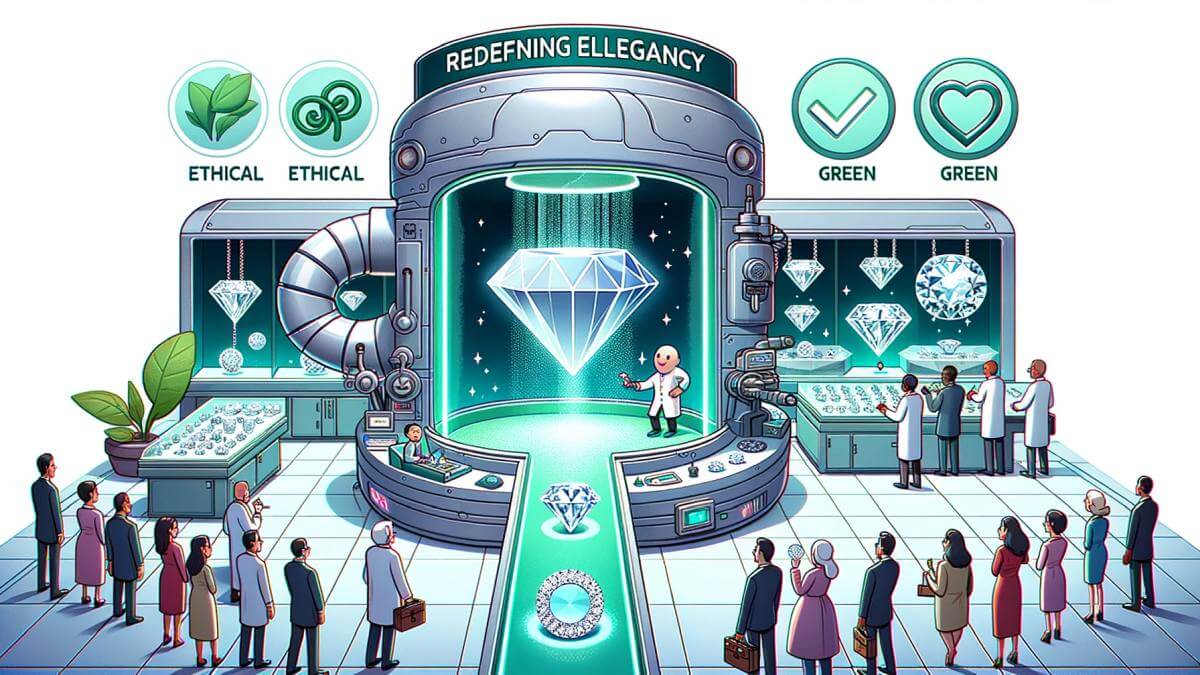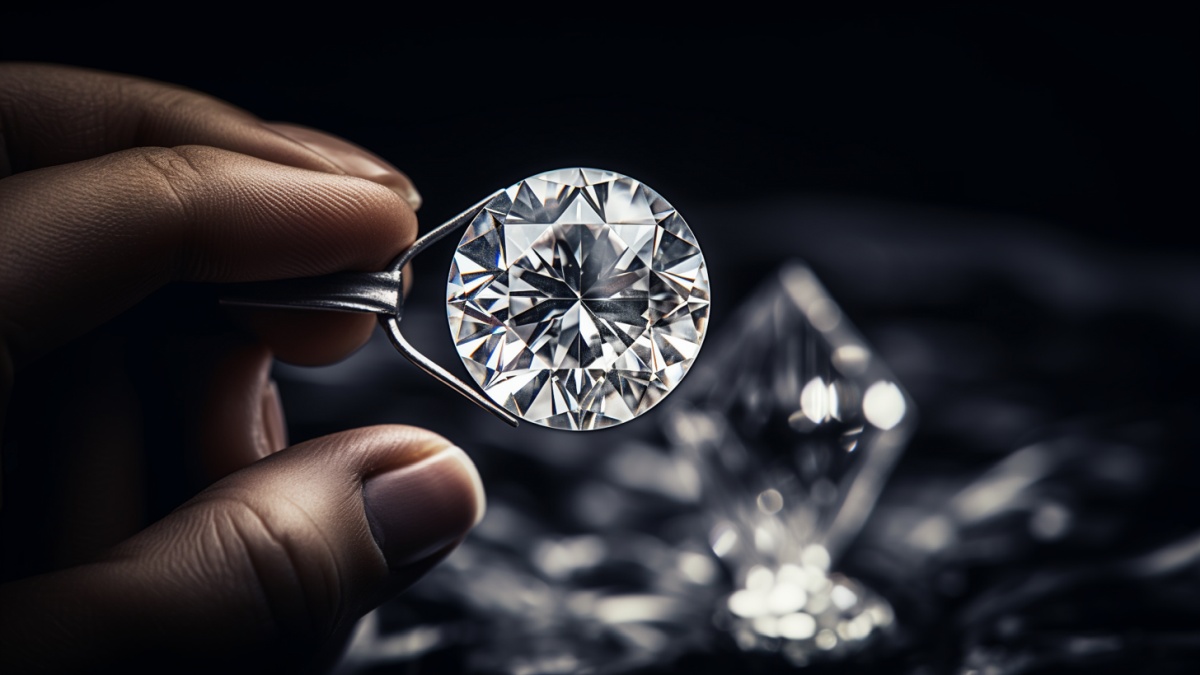Lab-grown diamond jewellery has recently emerged as a captivating alternative to traditional mined diamonds. The allure of these modern marvels lies in their identical appearance to mined diamonds and in the significant advancements in technology that have made their creation possible. The rising popularity of lab-grown diamonds is rewriting the narrative of luxury, melding elegance with ethical and eco-friendly practices.
Key Takeaways About Lab-Grown Diamond Jewellery From This Article:
- Lab-grown diamonds offer an identical look and similar physical and chemical properties to natural diamonds at a significantly lower cost.
- The creation of lab-grown diamonds through High-Pressure High-Temperature (HPHT) and Chemical Vapor Deposition (CVD) processes is a testament to technological advancements.
- The shorter supply chain of lab-grown diamonds contributes to their cost-effectiveness.
- Consumers are supporting a more ethical and environmentally sustainable alternative to mined diamonds by opting for lab-grown diamonds.
Appearance and Quality
Identical Look to Mined Diamonds
The allure of lab-grown diamonds primarily stems from their indistinguishable appearance compared to mined diamonds. Through modern technological processes, it's now possible to create diamonds in a controlled environment that exude the same sparkle and brilliance as their natural counterparts. They are a testament to how far science has come in mimicking nature's marvel.
Physical and Chemical Properties
Like mined diamonds, lab-grown diamonds boast exceptional physical and chemical properties. They share a similar level of hardness, sparkle, fire, and scintillation, making them equally desirable. Moreover, the quality and grade of lab-grown diamonds are assessed based on the same criteria used for natural diamonds, ensuring consumers are fully aware of the value they are receiving.
| Property | Mined Diamond | Lab-Grown Diamond |
| Hardness | 10 (Mohs Scale) | 10 (Mohs Scale) |
| Sparkle | High | High |
| Fire | High | High |
| Scintillation | High | High |
Processes Involved in the Creation of Lab-Grown or Synthetic Diamonds
Creating lab-grown diamonds involves two primary methods: High-Pressure High-Temperature (HPHT) and Chemical Vapor Deposition (CVD).
- HPHT: This process mimics the natural conditions under which diamonds are formed beneath the Earth's crust. It involves using high pressure and high temperature to transform carbon into diamonds.
- CVD: The Chemical Vapor Deposition process, on the other hand, involves depositing gas onto a substrate, which then crystallizes into a diamond. This method allows for more control over the purity and overall quality of the resulting diamond.
Our Lab-Grown Diamond Collection
Cost-Effectiveness
Lower Price Point
One of the major selling points of lab-grown diamonds is their cost-effectiveness. They are significantly cheaper than natural diamonds, making them an attractive option for budget-conscious consumers. The lower price point does not compromise the quality or appearance of the diamond, offering great value for money.
Top 6 Lab Grown Diamond Benefits
Shorter Supply Chain
The supply chain for lab-grown diamonds is much shorter and more straightforward than mined diamonds. There are fewer middlemen involved, which significantly reduces the overall cost. This saving is often passed down to the consumers, making lab-grown diamonds a more affordable option.
| Supply Chain Element | Mined Diamond | Lab-Grown Diamond |
| Mining | Yes | No |
| Cutting & Polishing | Yes | Yes |
| Wholesale | Yes | Often Bypassed |
| Retail | Yes | Yes |
| Pricing | High | Much Lower |
Price Comparison
Comparing the prices of lab-grown and natural diamonds showcases a clear advantage for the former. For instance, a 1-carat lab-grown diamond can cost 30% to 40% less than a natural diamond of the same size and quality.
The journey of lab-grown diamonds from labs to jewellery stores reflects how innovation can reshape traditional industries. By offering a blend of aesthetics, affordability, and ethical sourcing, lab-grown diamonds are not just a fleeting trend but a significant shift towards sustainable luxury in the jewellery market.
Environmental and Ethical Benefits
Lab-grown diamonds represent a leap towards more environmentally friendly and ethically sound practices in the jewellery industry. The process of creating these diamonds showcases how technology can be leveraged to curb the negative impacts associated with traditional diamond mining.
Environmental Impact of Lab-Grown vs Mined Diamonds
Less Water and Energy Consumption
Lab-grown diamonds are manufactured in controlled environments, significantly reducing the water and energy required compared to traditional mining operations. Given the growing concerns about water usage and energy consumption in various industries, this is a crucial advantage.
No Soil Erosion or Deforestation
Traditional diamond mining often results in soil erosion, deforestation, and other environmental degradation. On the other hand, producing lab-grown diamonds does not involve such detrimental effects, making them a more environmentally friendly option.
Lab-Grown Diamonds: Shining Stars of Sustainable Fashion
Ethical Labour Practices
The diamond mining industry has long been associated with exploitative labour practices. Lab-grown diamonds produced in controlled, safe environments provide a more ethical alternative as they are not linked to such labour issues.
Lab Grown Diamonds: Less Energy, Less Waste, Less Pollution, Lower Prices!
Increasing Popularity and Acceptance
Market Growth
The acceptance and popularity of lab-grown diamonds have been on a steady rise. The market value is projected to continue growing, reflecting a broader shift in consumer preferences towards more ethical and sustainable choices.
Lab Grown Diamond Jewellery: The Next Ten Years
Adoption by Major Jewellery Brands
Major jewellery brands are beginning to embrace lab-grown diamonds, further legitimizing their market position. The modern consumer, who is often more environmentally conscious and ethically minded, finds lab-grown diamonds compelling, aligning well with their values.
Lab-Grown Diamond Jewellery Trends
Other Benefits and Applications
More accessible Insurance Due to Lower Value
The lower value of lab-grown diamonds often makes them easier to insure, providing an added advantage to consumers who choose these over natural diamonds.
Beyond Jewellery: Medical and Industrial Applications
Lab-grown diamonds have applications beyond jewellery. Their hardness and thermal conductivity make them useful in various industries, including medicine and manufacturing, showcasing their versatility.
See Beautiful Real Diamond Jewellery For Yourself – And Be Inspired!
Explore the perfect blend of elegance, ethical sourcing, and eco-friendly practices with lab-grown diamond jewellery from Afterdiamonds.co.uk.
Browse our handcrafted collections of high-quality jewellery, each piece a testament to UK craftsmanship and the incredible advancements in diamond creation technology.
Experience the identical sparkle and brilliance of mined diamonds at a significantly lower cost while supporting a more ethical and environmentally sustainable alternative.
With a lifetime workmanship guarantee and a 30-day return or exchange policy, we ensure you will find the perfect piece that reflects your style and values. Dive into the world of sustainable luxury today!
Frequently Asked Questions About Lab-Grown Diamonds
1. What are lab-grown diamonds, and how do they compare to mined diamonds?
- Lab-grown diamonds are created in a controlled laboratory environment using advanced technological processes: High-Pressure High-Temperature (HPHT) and Chemical Vapor Deposition (CVD). They offer an identical look and similar physical and chemical properties to natural diamonds but at a significantly lower cost.
2. How are lab-grown diamonds made?
- Lab-grown diamonds are created through two primary methods: High-Pressure High-Temperature (HPHT), which mimics the natural conditions under which diamonds are formed beneath the Earth's crust, and Chemical Vapor Deposition (CVD), where gas is deposited onto a substrate, crystallizing into diamond.
3. What are the benefits of choosing lab-grown diamonds over mined diamonds?
- Opting for lab-grown diamonds supports more ethical and environmentally sustainable practices. They are cost-effective due to a shorter supply chain and don't contribute to soil erosion, deforestation, or exploitative labour practices common in traditional diamond mining.
4. Are lab-grown diamonds of similar quality to mined diamonds?
- Yes, lab-grown diamonds boast exceptional physical and chemical properties similar to mined diamonds. They share a similar level of hardness, sparkle, fire, and scintillation. The quality and grade of lab-grown diamonds are also assessed based on the same criteria used for natural diamonds.
5. Why are lab-grown diamonds more cost-effective?
- Lab-grown diamonds are more cost-effective due to a shorter and simpler supply chain with fewer middlemen involved. Additionally, the absence of mining operations reduces the overall cost, making them an attractive option for budget-conscious consumers.
6. What is the environmental impact of lab-grown diamonds compared to mined diamonds?
- Lab-grown diamonds require significantly less water and energy and do not cause soil erosion or deforestation. This makes them a more environmentally friendly alternative than traditional mined diamonds, which often result in environmental degradation.
7. Are there other applications for lab-grown diamonds besides jewellery?
- Besides jewellery, lab-grown diamonds have applications in various industries, including medicine and manufacturing, due to their hardness and thermal conductivity. This versatility showcases the broader potential of lab-grown diamonds beyond the realm of jewellery.




